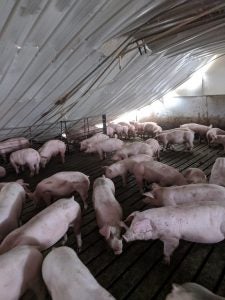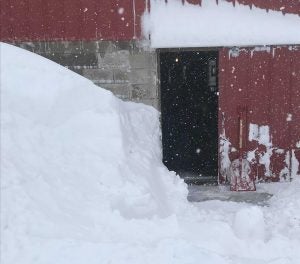April has been a rough month.
While some farmers are dealing with low prices and trying to figure out how they’ll pull through and make ends meet, the wildfires in Oklahoma continue to burn. Areas of Wisconsin and Minnesota have had the worst snowstorm in over 129 years, getting dumped on in some areas by almost 30 inches of snow. Barn roofs have caved in; many farm animals have lost their lives. Farmers struggle to fight extremely strong winds, while relying on the help of neighbors, friends, family, and organizations to rehome their animals or find creative ways to get the cows milked.
Billie Brockshus Gervais was one of those farmers. Located in Southwest Minnesota, the 40+ mph winds and heavy snow made two of the double wide barn roofs collapse. With the help of local trucking companies, six loads of pigs (1,200 of them) were relocated to another farm while the insurance companies and engineers inspected the structural damage of the barns to ensure safety. It will take some time to rebuild, and a small number of pigs were lost, but hopefully insurance is fair to rebuild the 16,000-head pork operation. Local community and church groups are also there to aid with people who have been affected by the winter storm.

Other problems that have occurred in the Midwest during the snow? Injured animals escaping with the structural damage, trucks getting stuck and unable to collect milk, etc. The community had to come together to shovel each other out while the snow came down faster than many folks could handle — some snow drifts reached up to 10 feet.

Meanwhile, with less than a half-inch of rain over a six-month period, residents of Dewey and Woodward counties in Oklahoma are losing their farms and homes to major fires. The extreme drought conditions combined with 40 mph winds and a very low (3 percent) relative humidity have made the area a breeding ground for fire. All it took was a little spark now nearly 350,000 acres have been burned.
Mike Weber from the Dewey County Oklahoma State University Extension office took a phone call with me to further explain the damages and what people can do to help.
No. 1 – Help with hay donations
No. 2 – Donate fencing supplies
These are the two main needs, but many farm communities are coming to the rescue with the help of home and farm supplies and monetary donations. The areas of Oklahoma that are cow/calf operations have pastures that are well managed and not over grazed; it’s rough land with lots of trees that have added fuel to the fire. Some ranchers have lost a fourth to two-thirds of their herd while livestock are being shipped to other parts of the country to save them. Fencing is out; feed has burned to the ground. On top of the farming problems, nearly 100 homes have also been engulfed in flames.
How can we help? The purpose of sharing these stories is to raise awareness to those going through a tough time right now. Appreciate the work that goes into producing food, and find ways we can help. A couple resources and organizations helping to aid those in need are:
Bad things happen to all of us in life at some point. In the words of Will Rogers, “A farmer has to be an optimist or he wouldn’t still be a farmer.”
In the words of Wisconsin dairy farmer Andrew Herro: “What else can be done but rebuild? We just have to maintain our courage and our optimism and keep marching forward. We hope that our insurance coverage will be fair and sufficient. We hope that the fields will quickly dry and warm so we can get our crops in the ground. We hope that the price for our products will improve so we can pay our bills. We continue through whatever adverse conditions are brought upon us.”
Truer words have never been spoken. Our thoughts, love, prayers, and support go out to all those who have been affected by this tragedy.
Michelle Miller, the Farm Babe, is an Iowa-based farmer, public speaker, and writer, who lives and works with her boyfriend on their farm, which consists of row crops, beef cattle, and sheep. She believes education is key in bridging the gap between farmers and consumers.



